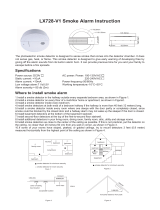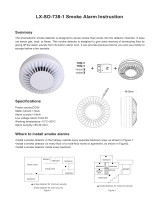
Confidential. SyberSense IOT Company
GENERAL MAINTENANCE
To keep your Smoke/CO detector in good working order, please follow these simple steps. Verify alarm siren, LED lights, and
battery operation by pushing the test buttons at least once a week. Remove the device from the mounting bracket and vacuum
the detector cover and vents with a soft brush attachment once a month to remove dust and dirt. Reinstall immediately after
cleaning and then test using the tests button.
Never attempt to disassemble the unit or clean inside of it as this will void your warranty. Never use detergents or solvents to
clean the unit. When household cleaning supplies or similar contaminates are used, the area must be well ventilated. The
following substances can damage the sensors and may cause false reading: methane, propane, isobutene, isopropanol, ethyl
acetate, hydrogen sulfide, sulfide dioxides, alcohol base products, paints, thinner, solvents, adhesives, hair spray, after shave,
pertume, and some cleaning agents. Do not paint the detector. Paint will seal the vents and interfere with its ability to detect
smoke and CO. Move the detector prior to performing any of the following: staining or stripping wood floors or furniture, painting,
wall papering, using adhesives. Store the detector in a plastic bag during any of the above projects to help protect the sensors
from damage. Make sure to reinstall the detector once done so as to assure continuous protection.
IF CO ALARM ACTIVATES
Actuation of your CO alarm indicates the presence of carbon monoxide (CO) which can kill you. If CO is detected, follow these
steps. Thoroughly familiarize yourself with these items and review them with all of your family members.
△
!WARNING!!
Actuation of your CO detector indicates the presence of carbon monoxide (CO) which can KILL YOU. If alarm signal sounds:
1) Operate reset/silence button
2) Call your emergency services (Telephone Number) [fire department or 911];
3) Immediately move to fresh air – outdoors or by an open door/window. Do a head count to check that all persons are
accounted for. Do not reenter the premises nor move away from the open door/window until the emergency services
responders have arrived, the premises have been aired out, and your alarm remains in its normal condition.
4) After following steps 1 – 3, if your alarm reactivates within a 24 hour period, repeat steps 1 – 3 and call a qualified appliance
technician (Telephone Number) to investigate for sources of CO from fuel burning equipment and appliances, and inspect for
proper operation of this equipment. If problems are identified during this inspection have the equipment serviced immediately.
Note any combustion equipment not inspected by the technician and consult the manufacturers’ instructions, or contact the
manufacturers directly, for more information about CO safety and this equipment. Make sure that motor vehicles are not, and
have not been, operating in an attached garage or adjacent to the residence.
ACTIONS TO TAKE AFTER THE PROBLEM BEING CORRECTED
Once the problem about the CO gas presence in the premises has been corrected, the alarm of the CO alarm unit should be
off. After waiting for 10 minutes, push the Test button to test the CO alarm unit so that you can make sure that it is working
properly again.
TECHNICAL INFORMATION FOR CO ALARM
According to the UL2034 has already established the carbon monoxide concentrations and exposure time standards for the
alarms, which is specified below:
UL2034:
At 70ppm, the unit must alarm within 60-240 minutes
At 150ppm, the unit must alarm within 10-50 minutes
At 400ppm, the unit must alarm within 4-15 minutes
IF SMOKE ALARM ACTIVATES
Never ignore the sound of the alarm. Check for signs of fire or smoke throughout the residence. If a fire is discovered, follow the
steps list below. Thoroughly familiarize yourself with these items and review them with all of your family members.
Smoke alarms may not awaken all sleeping individuals, and that it is the responsibility of individuals in the household that
are capable of assisting others to provide assistance to those who may not be awakened by the alarm sound, or to those
who may be incapable of safely evacuating the area unassisted. Leave immediately using one of your pre-planned escape
routes. Every second counts .Do not get dressed or pick up valuables.
Before opening inside doors, look for smoke seeping in around edges. Feel the door with the back of your hand. If the door
is hot, try to use another exit. If you feel it is safe, open the door very slowly but be prepared to close it should smoke rush
in.
If your escape route requires you to go through smoke, crawl low and under the smoke where the air is clearer.

















